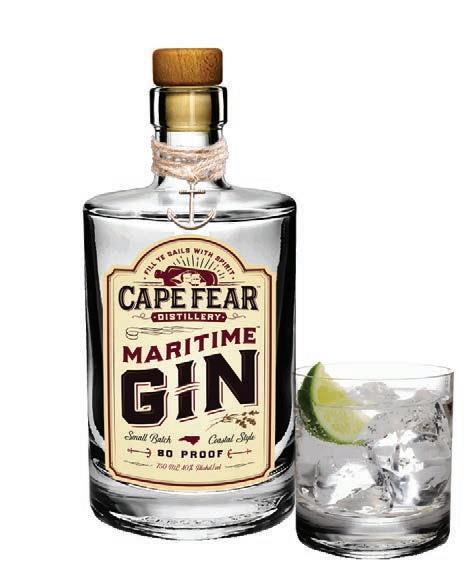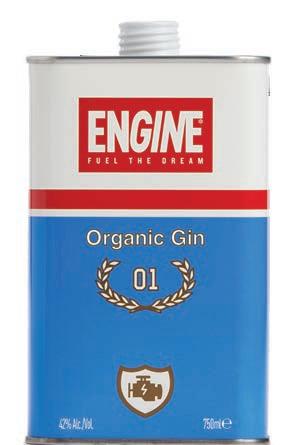
6 minute read
HOW GIN GOT ITS GROOVE BACK
Whiskey. Vodka. Rum. These alcoholic beverages have been known to win the popularity contest among consumers. However, there’s a new contender in the mix—gin. It’s no longer “our grandfather’s drink.” Gin has become multi-generational and is garnering the attention it has always deserved. The increase in demand for gin is not in question. What we really want to know is when and how it happened.
A STORY FILLED TO THE BRIM WITH SPIRIT
In the most basic terms, gin is a liquor that is approximately 80 proof or greater. Derived from grain distillation, the prevailing aroma and flavor of Juniper is what puts gin in a category of its own. The layered complexity of its flavor palate aligns perfectly with its history—a journey through time filled with culture and the right amount of tradition mixed with innovation. There are records of people using juniper to cure stomach ailments dating back to Roman times. After that, the Dutch perfected jenever, which became known as “Dutch courage” since it helped invigorate their soldiers on the battlefield. The British then contributed to the storyline by refining the London dry gin we know today. The various chapters in this timeline eventually led to the creation of the infamous gin & tonic, which at that time supported the Royal Navy in India. So, in a way, history itself has helped contribute to gin’s appeal among current mainstream society. Adam von Gootkin, co-founder and CEO of Highclere Castle Spirits (highclerecastlegin.com), agrees that gin’s past has impacted its growing popularity. He said, “I think anything that is relatively ancient is bound to fascinate. What other spirit has had such an adventure through the centuries? Today, we honor this history in the very liquification of Highclere Castle Gin and around the world through the art of the cocktail.” The evolution of gin in and of itself is intriguing. Gin’s rise in popularity has its own story to tell.
ANALYZING THE RESURGENCE OF GIN
Gin sales increased significantly during the last few years, with just under 9.3 million cases sold. From 2020 to 2021, gin showed it meant business with a sales growth rate of 21 percent! Premium craft gin made up a majority of these purchases, proving the level of sophistication and appreciation these newfound gin consumers possessed. Although, some producers of gin began recognizing these favorable market transformations much earlier.
Alex Munroe, Owner of Cape Fear Vineyard and Winery, LLC, (capefearwinery.com) first noticed a rise in the demand for gin in 2014. He believes this resulted from millennials’ seeking a smooth and refreshing alternative to vodka and heavier whiskeys. Munroe stated, “By itself, gin has a powerful juniper taste that doesn’t necessarily hold universal appeal. However, when mixed into cocktails, the spirit lends itself to other exquisitely delightful flavors. As such, gin is more relevant today as newcomers discover the benefits of its flexibility.” von Gootkin has also witnessed a significant surge in gin’s global uptrend during the past few years. In fact, Highclere Castle Gin falls in the super-premium category, which is the fastest-growing spirits category in the U.S., and has his own theories for why this is the case. Taking note of an overall increased appeal of nostalgia, Gootkin said, “I think consumers, especially the younger generation learning about cocktail culture, are excited to know about the classics our grandparents and great grandparents enjoyed. They are discovering that gin offers a wide range of sophistication and complexity other spirits can’t provide.” The reason for gin’s revitalization doesn’t come down to one single attribute. Aside from its versatility, this spirit has many other good things going for it. With an impressive resume of crowd-pleasing traits, all signs point to gin continuing to play a lead role in the alcoholic beverage industry.
DRIVING FACTORS BEHIND GIN’S FAST-PACED GROWTH
Gin has quite a few advantages. And the fact that age doesn’t matter is one of them. Unlike a bottle of wine or whiskey, maturity is not a determining factor for the quality or taste of gin. With a shorter timeline from distillation to distribution, gin brands are able to bring a product to market at a much faster rate. Another benefit is gin’s compatibility in the ever-growing RTD (Ready To Drink) category. With canned cocktails being well received in the beverage market, there is an opportunity for gin-based drinks to make a name for themselves in this particular category. As mentioned earlier, the flavor combinations are endless with their amazing versatility. In addition to its ability to align with current trends, gin has an innate knack for innovation and creating premium crafts. It is more than an alcoholic beverage—it is an art form. The end product tells a narrative of people, place, and a passion for the process. von Gootkin
pointed out, “Like in wine, well-made gin truly reflects the terroir of the land from which it’s made. In our case, Highclere Castle Gin is citrus-forward as we source our citrus from the Victorian Orangery behind Highclere Castle. We source our lavender from the walled monks’ garden on the castle estate, and our prize-winning oats come directly from Highclere’s soil which has been used to feed the world’s top thoroughbred horses.” What you put in has a lot to do with the experience consumers get out of a gin. And this acts as the perfect segway to the next attractive characteristic. Believe it or not, gin is one of the healthiest spirits ever created. Juniper berries, the staple ingredient of gin, are a type of “superfruit” that fights infections with significant amounts of vitamin C and flavonoids. Gin is also high in antioxidants and low in calories. With so many health benefits to sip on and so many gins to try, it’s no wonder this beverage is experiencing a boom.

IN GOOD SPIRITS ABOUT THE FUTURE
It is safe to say that gin will continue to follow its current upward trend, especially with innovation on its side. According to Munroe, “The requirements for gin state that its main characteristic must be derived from juniper berries. This leaves room for other aromatics and flavors to be added to make an array of unique gins that complement the juniper.” You don’t have to look far before coming across the creativity that is already being capitalized within the gin category. Some come in the form of packaging and brand conceptualization, like in the case of Engine Gin (engine.land/engine). A hand-crafted London dry gin that stands out with its bold visual components of oil and fuel cans. Others are playing with ways to please the palate as Sipsmith releases limited editions sipspresso coffee gin and Aldi introduces new fruit-flavored gins to its inventory. Let’s not forget about the low to no alcohol demographic. Gin is producing some delightful plant-based alternatives.
The chameleon of the wine and spirits world, gin has all the makings of a “perfect for any occasion, mixes well with anything, rich in history and in flavor” type of drink. This is a spirit that has proven patient and persistent until it was able to earn its spot in the limelight. And for those very reasons, Gin is not simply making a comeback. It is here to stay.

Stephanie Blitz was born and raised in Milwaukee and currently resides in Las Vegas with her husband and two children. She is a proud #boymom and the founder of Architect Of Words. Stephanie is a freelance writer and marketing maven who believes in the power of coffee, values experiences over things and recognizes the ability words have to connect people.










